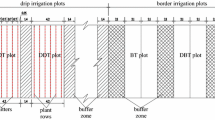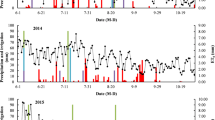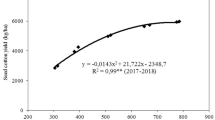Abstract
Cotton is a relatively new crop in southern Kansas and its effective irrigation scheduling requires information on crop water requirement and water productivity in a given climatic condition. This study aimed to: (1) assess cotton crop actual evapotranspiration, irrigation water requirement, (2) evaluate lint yield and quality, and (3) determine the water productivity related to total water (irrigation and rainfall), irrigation, and evapotranspiration under different irrigation technologies and rainfed conditions in semi-arid climate of western Kansas. Field experiments were conducted in 2020, 2021, and 2022 at the Southwest Research and Extension Center (SWREC) in Garden City, KS, to evaluate cotton production under four irrigation technologies which were low elevation spray application (LESA), low energy precision application (LEPA), mobile drip irrigation 1 (MDI1 with 3.79 L/h), mobile drip irrigation 2 (MDI2 with 7.57 L/h) and a rainfed treatment under a randomized complete block design with the variety PHY 205 W3FE. Crop management was similar across all treatments for three growing seasons. The results showed that the seasonal actual evapotranspiration (ETa) varied among the irrigation technologies, the rainfed treatment, and years. On average, LESA recorded the highest ETa value of 463.9 mm and LEPA had the lowest ETa value of 457.2 mm. The lint yield and lint quality (micronaire, length, strength, uniformity, color grade) varied significantly among the irrigation technologies and the rainfed setting. The highest lint yield of 1061.94 kg ha−1 was obtained under LEPA, while the rainfed registered the lowest lint yield of 224.13 kg ha−1. The irrigated cotton had a high value for lint quality parameters with the LEPA having the best lint quality. Furthermore, on average, LEPA recorded the highest evapotranspiration-water, total-water, and irrigation-water use efficiencies, and the values were 0.23, 0.33, and 0.39 kg m−3, respectively. The cotton ETa and water productivity are valuable parameters for effective irrigation scheduling for cotton production under similar climate and soil conditions.








Similar content being viewed by others
Data availability
The data from the experiments are available from the authors upon request.
References
Ajaz A, Datta S, Stoodley S (2020) High plains aquifer–state of affairs of irrigated agriculture and role of irrigation in the sustainability paradigm. Sustainability 12:3714. https://doi.org/10.3390/su12093714
Allen RG, Pereira LS, Raes D, Smith M (1998) Crop evapotranspiration: guidelines for computing crop water requirements. In: United Nations FAO, Irrigation and Drainage Paper 56. FAO, Rome
Anac S, Ul MA, Tuzel IH, Anac ̧ D, Okur B, Hakerler H (1999) Optimum irrigation scheduling for cotton under deficit irrigation conditions. In: Kırda C, Moutonnet P, Hera C, Nielsen DR (eds) Crop yield response to deficit irrigations. Kluwer Academic Publishers, Dordrecht
Anandhi A (2016) Growing degree days–ecosystem indicator for changing diurnal temperatures and their impact on corn growth stages in Kansas. Ecol Indic 61:149–158
Anapalli SS, Fisher DK, Pinnamaneni SR, Reddy KN (2020) Quantifying evapotranspiration and crop coefficients for cotton (Gossypium hirsutum L.) using an eddy covariance approach. Agric Water Manag 233:106091. https://doi.org/10.1016/j.agwat.2020.106091
Bajpai P (2018) Refining and pulp characterization. In: Bajpai P (ed) Biermann’s handbook of pulp and paper: paper and board making. Elsevier, Amsterdam
Basal H, Dagdelen N, Unay A, Yilmaz E (2009) Effects of deficit drip irrigation ratios on cotton (Gossypium hirsutum L.) yield and fibre quality. J Agron Crop Sci 195:19–29. https://doi.org/10.1111/j.1439-037X.2008.00340.x
Baumhardt RL, Haag LA, Gowda PH, Schwartz RC, Marek GW, Lamm FR (2021) Modeling cotton growth and yield response to irrigation practices for thermally limited growing seasons in Kansas. Trans ASABE 64(1):1–12. https://doi.org/10.13031/trans.13877
Bezerra BG, da Saliva BB, Bezerra JRC, Sofiatti V, dos Santos CAC (2012) Evapotranspiration and crop coefficient for sprinkler-irrigated cotton crop in ApodiPlateau semiarid lands of Brazil. Agric Water Manag 107:86–93
Bordovsky JP (2019) Low-energy precision application (LEPA) irrigation: a forty-year review. Trans ASABE 62:1343–1353. https://doi.org/10.13031/trans.13117
Colaizzi PD, Evett SR, Howell TA (2004) Irrigation methods and capacities for cotton in the northern high plain. In: Rainwater KA, Zobeck TM (eds) High plains groundwater resources: challenges and opportunities, conference proceedings, Texas Tech University Water Resources Center, Lubbock, TX, 7–9 December 2004
Colaizzi PD, Evett SR, Howell TA (2005) Cotton production with SDI, LEPA, and spray irrigation in a thermally-limited climate. In: Proceedings of the Irrigation Association Conference, Phoenix, AZ, 6–8 November 2005
Dagdelen N, Basal H, Yilmaz E, Gürbüz T, AkçAy S (2009) Different drip irrigation regimes affect cotton yield, water use efficiency and fiber quality in western Turkey. Agric Water Manag 96:111–120. https://doi.org/10.1016/j.agwat.2008.07.003
Djaman K, Irmak S (2012) Soil water extraction patterns, crop, irrigation, and evapotranspiration water use efficiency under full and limited irrigation and rainfed conditions. Trans ASABE 55:1223–1238
Ertek A, Kanber R (2001) Water-use efficiency (WUE) and change in the yield response factor (ky) of cotton irrigated by a drip irrigation system. Turk J Agric Forest 25:111–118
Evett SR, Baumhardt RL, Howell TA, Ibragimov NM, Hunsaker DJ (2012) Cotton. In: Crop yield response to water; FAO irrigation and drainage paper no. 66. FAO, Rome, pp 152–161
Faostat (2022) https://www.fao.org/faostat/en/#data/QCL. Accessed 1 May 2022
Farahani H, Munk D (2012) Why irrigate cotton? In: Perry C, Barnes E (eds) Cotton irrigation management for humid regions. Cotton Incorporated, Cary, NC, p 1–6. https://www.cottoninc.com/wp-content/uploads/2017/03/cotton-irrigation-schedule.pdf. Assessed 8 Aug 2022
Farahani HJ, Oweis TY, Izzi G (2008) Crop coefficient for drip-irrigated cotton in a Mediterranean environment. Irrig Sci 26:275–383
Feng L, Mathis G, Ritchie G, Han Y, Li Y, Wang G, Zhi X, Bednarz CW (2014) Optimizing irrigation and plant density for improved cotton yield and fiber quality. Agron J 106:1111–1118. https://doi.org/10.2134/agronj13.0503
Gao M, Snider JL, Bai H, Hu W, Wang R, Meng Y, Wang Y, Chen B, Zhou Z (2020) Drought effects on cotton (Gossypium hirsutum L.) fibre quality and fibre sucrose metabolism during the flowering and boll- formation period. J Agron Crop Sci 206:309–321
Gowda PH, Baumhardt RL, Esparza AM, Marek TH, Howell TA (2007) Suitability of cotton as an alternative crop in the Ogallala aquifer region. Agron J 99(6):1397–1403. https://doi.org/10.2134/agronj2006.0275
Grismer ME (2002) Regional cotton lint yield, ETc, and water value in Arizona and California. Agric Water Manag 54:227–242
Hake K, Bragg K, Mauney J, Metzer B (1990) Causes of high and low micronaire. Physiology today. University of Georgia Extension cotton agronomist 1(12), 4p. https://www.cotton.org/tech/physiology/cpt/fiberquality/upload/CPT-Sep90-REPOP.pdf
Heumann C, Schomaker M, Shalabh (2016) Introduction to statistics and data analysis, with exercises, solutions, and applications in R. Springer, Berlin. https://link.springer.com/book/. https://doi.org/10.1007/978-3-319-46162-5
Hinze L, Kohel R (2012) Cotton. In: Gupta S (ed) Technological innovations in major world oil crops, vol. 1. Springer, New York, NY. https://doi.org/10.1007/978-1-4614-0356-2_9.
Holladay SK, Bridges WC, Jones MA, Campbell BT (2021) Yield performance and fiber quality of Pima cotton grown in the southeast United States. Crop Sci 61:2423–2434
Howell TA, Davis KR, McCormick RL, Yamada H, Walhood VT, Meek DW (1984) Water use efficiency of narrow row cotton. Irrig Sci 5:195–214. https://doi.org/10.1007/BF00264608
Howell TA, Evett SR, Tolk JA, Schneider AD (2004) Evapotranspiration of full-, deficit-irrigated, and dryland cotton on the Northern Texas High Plains. J Irrig Drain Eng 130(4):277–285. https://doi.org/10.1061/ASCE0733-94372004130:4277
Hsieh YL (2007) Chemical structure and properties of cotton. Chapter 1. Book. Cotton: science and technology. 34p. https://doi.org/10.1533/9781845692483.1.3
Hu W, Snider JL, Wang HM, Zhou ZG, Chastain DR, Whitaker J, Bourland FM (2018) Water-induced variation in yield and quality can be explained by altered yield component contributions in field-grown cotton. Field Crop Res 224:139–147. https://doi.org/10.1016/j.fcr.2018.05.013
Irmak S, Djaman K, Sharma V (2015) Winter wheat (Triticum aestivum L.) evapotranspiration and single and basal crop coefficients. Trans ASABE 58:1047–1067
Karam F, Lahoud R, Masaad R, Daccache A, Mounzer O, Rouphael Y (2006a) Water use and lint yield response of drip irrigated cotton to the length of irrigation season. Agric Water Manag 85:287–295
Karam F, Lahoud R, Masaad R, Daccache A, Mounzer O, Rouphael Y (2006b) Water use and lint yield response of drip irrigated cotton to the length of irrigation season. Agric Water Manag 85:287–295
Ko J, Piccinni G, Marek T, Howell T (2009) Determination of growth-stage-specific crop coefficients (Kc) of cotton and wheat. Agric Water Manag 96:1691–1697
Koudahe K, Sheshukov AY, Aguilar J, Djaman K (2021) Irrigation-water management and productivity of cotton: a review. Sustainability 13:10070. https://doi.org/10.3390/su131810070
Kramer PJ, Boyer JS (1995) Water relations of plants and soils. Academic press, San Diego. http://udspace.udel.edu/handle/19716/2830
Kumar K, Udeigweb TK, Clawsonc EL, Rohlid RV, Miller DK (2015) Crop water use and stage-specific crop coefficients for irrigated cotton in the mid-south, United States. Agric Water Manag 156:63–69
Li X, Lei Y, Han Y, Wang Z, Wang G, Feng L, Du W, Fan Z, Yang B, Xiong S, Xing F, Xin M, Li Y (2021) The relative impacts of changes in plant density and weather on cotton yield variability. Field Crop Res 270:108202. https://doi.org/10.1016/j.fcr.2021.108202
Liu Y, Jiang H, Li C, Huang H, Pan Z, Chai C (2013) Analysis of irrigation water requirement and irrigation requirement index for cotton of Hebei province. Nongye gongcheng xuebao/transactions of the Chinese society of agricultural engineering 29(19):98–104. https://doi.org/10.3969/j.issn.1002-6819.2013.19.012
Liu Y, Snider JL, Bhattarai A, Collins G (2022) Economic penalties associated with irrigation during high rainfall years in the southeastern United States. Agric Water Manag 272:107825. https://doi.org/10.1016/j.agwat.2022.107825
Luckey RR, Osborn NI, Becker MF, Andrews WJ (2020) Water flow in the high plains aquifer in Northwestern Oklahoma. United States Geological Survey, 4p. https://pubs.usgs.gov/fs/FS-081-00/pdf/fs-081-00.pdf
Luo H, Zhang Y, Zhang W (2008) Effects of rewatering after drought stress on photosynthesis and yield during flowering and boll-setting stage of cotton under-mulch-drip irrigation in Xinjiang. Acta Agron Sin 34:171–174. https://doi.org/10.3724/SP.J.1006.2008.00171
Lyle WM, Bordovsky JP (1983) LEPA irrigation system evaluation. Trans ASAE 26:776–781
Masasi B, Taghvaeian S, Boman R, Moriasi DN, Starks PJ (2020) Impacts of variable irrigation regimes on cotton yield and fiber quality. Agric Environ Lett 5:e20031. https://doi.org/10.1002/ael2.20031
McGuire VL (2017) Water-level and recoverable water in storage changes, high plains aquifer, predevelopment to 2015 and 2013–15: U.S. Geological Survey Scientific Investigations Report 2017–5040, 14p. https://doi.org/10.3133/sir20175040
Meredith WR, Bridge R (1973) Yield, yield component and fiber property variation of cotton (Gossypium hirsutum L.) within and among environments. Crop Sci 13:307–312
Nilesh B, Gulati HS, Mukund N (2005) Effect of drip and sprinkler irrigation system on growth and yield of American cotton (Gossypium hirsutum L.). Bioved 16:33–37
Oker TE, Kisekka I, Sheshukov AY, Aguilar J, Rogers D (2020) Evaluation of dynamic uniformity and application efficiency of mobile drip irrigation. Irrig Sci 38:17–35. https://doi.org/10.1007/s00271-019-00648-0
Oker TE, Sheshukov AY, Aguilar J, Rogers DH, Kisekka I (2021) Evaluating soil water redistribution under mobile drip irrigation, low-elevation spray application, and low-energy precision application using HYDRUS. J Irrig Drain Eng 147(6):04021016
Orgaz F, Mateos L, Fereres E (1992) Season length and cultivar determine the optimum evapotranspiration deficit in cotton. Agron J 84:700–706
Peng S, Krieg DR, Hicks SK (1989) Cotton lint yield response to accumulated heat units and soil water supply. Field Crop Res 19(4):253–262. https://doi.org/10.1016/0378-4290(89)90097-X
Pettigrew WT (2004) Moisture deficit effects on cotton lint yield, yield components, and boll distribution. Agron J 96:377–383. https://doi.org/10.2134/agronj2004.0377
Ramey HH Jr (1986) Stress influences on fiber development. Cotton physiology. The Cotton Foundation, Memphis, TN, pp 315–359
Segarra E, Almas L, Bordovsky JP (1999) Adoption of advanced irrigation technology: LEPA vs. drip in the Texas High Plains. Proc Beltwide Cotton Conf 1:324–328
Snowden C, Ritchie G, Thompson T (2013) Water use efficiency and irrigation response of cotton cultivars on subsurface drip in west Texas. J Cotton Sci 17:1–9
Sorensen RB, Lamb MC, Butts CL (2020) Crop rotation, irrigation system, and irrigation rate on cotton yield in southwestern Georgia. Crop Forage Turfgrass Manag 6:e20053. https://doi.org/10.1002/cft2.20053
Stone LR, Klocke NL, Schlegel AJ, Lamm FR, Tomsicek DJ (2011) Equations for drainage component of the field water balance. Appl Eng Agric 27(3):345–350. https://doi.org/10.13031/2013.37076
Sui R, Byler RK, Delhom CD (2017) Effect of nitrogen application rates on yield and quality in irrigated and rainfed cotton. J Cotton Sci 21:113–121
Tennakoon SB, Milroy SP (2003) Crop water use and water use efficiency on irrigated cotton farms in Australia. Agric Water Manage 61:179–194
Thorp KR, Ale S, Bange MP, Barnes EM, Hoogenboom G, Lascano RJ, Rajan N (2014) Development and application of process-based simulation models for cotton production: a review of past, present, and future directions. J Cotton Sci 18(1):10–47
Tokatlidis I, Tsikrikoni C, Tsialtas J, Lithourgidis A, Bebeli P (2008) Variability within cotton cultivars for yield, fibre quality and physiological traits. J Agric Sci 146:483–490. https://doi.org/10.1017/S0021859608007867
Tolk JA, Howell TA (2010) Cotton water use and lint yield in four great plains soils. Agron J 102:904–910. https://doi.org/10.2134/agronj2009.0398
USDA (2018) The classification of cotton. 32p. https://www.cottoninc.com/wp-content/uploads/2017/02/Classification-of-Cotton.pdf. Accessed 8 Jun 2022
USDA (2022) Cotton sector at a glance. Economic Research Service USDA. https://www.ers.usda.gov/topics/crops/cotton-wool/cotton-sector-at-a-glance. Accessed 12 Dec 2022
Wang R, Ji S, Zhang P, Meng Y, Wang Y, Chen B, Zhou Z (2016) Drought effects on cotton yield and fiber quality on different fruiting branches. Crop Sci 56:1265–1276
Wanjura DF, Upchurch DR, Mahan JR (2002) Cotton yield and applied water relationships under drip irrigation. Agric Water Manage 55:217–237
Whitaker JR, Ritchie GL, Bednarz CW, Mills CI (2008) Cotton subsurface drip and overhead irrigation efficiency, maturity, yield, and quality. Agron J 100:1763–1768. https://doi.org/10.2134/agronj2008.0036
Witt TW, Ulloa M, Schwartz RC, Ritchie GL (2020) Response to deficit irrigation of morphological, yield and fiber quality traits of upland (Gossypium hirsutum L.) and Pima (G. barbadense L.) cotton in the Texas High Plains. Field Crop Res 249:107759. https://doi.org/10.1016/j.fcr.2020.107759
Wright DL, Sprenkel RK, Marois JJ (2005) Cotton growth and development. Univ. Fla. Agron. Dep. Fla. Coop. Ext. Serv. IFAS Ext. Publ. SSAGR-238, Gainsville, FL
Yagmur B, Gurel A, Oren Y (2014) Effects of different drought applications and potassium doses on cotton yield and fiber quality. Res J Agric Environ Manag 3:060–067
Yang Z, Qanmber G, Wang Z, Yang Z, Li F (2020) Gossypium genomics: trends, scope, and utilization for cotton improvement. Trends Plant Sci 25(5):488–500. https://doi.org/10.1016/j.tplants.2019.12.011
Yazar A, Sezen SM, Sesveren S (2002) LEPA and trickle irrigation of cotton in the Southeast Anatolia Project (GAP) area in Turkey. Agric Water Manag 54:189–203
Zhang D, Luo Z, Liu S, Li W, WeiTang DH (2016) Effects of deficit irrigation and plant density on the growth, yield and fiber quality of irrigated cotton. Field Crop Res 197:1–9. https://doi.org/10.1016/j.fcr.2016.06.003
Acknowledgements
The authors thank M.B. Kirkham, Ph.D., University Distinguished Professor, Department of Agronomy, Kansas State University, for editing the manuscript for English. Our gratitude goes to the water resource engineering staff of K-State Southwest Research and Extension Center, Garden City, Kansas, for their support during field data collection. K.K. thanks the Fulbright program for supporting the study at Kansas State University.
Funding
A.S. acknowledges support from the USDA Hatch Project No. S-1089, this publication is contribution number 24-063-J from the Kansas Agricultural Experiment Station, Manhattan, Kansas.
Author information
Authors and Affiliations
Contributions
Conceptualization and methodology, J.A., A.S., K.D., K.K., writing-original draft preparation, K.K.; writing-review and editing, J.A., A.S., K.D., M.B.K, K.K.; All authors have read and agreed to the published version of the manuscript.
Corresponding authors
Ethics declarations
Conflict of interest
The authors declare no conflict of interest.
Additional information
Publisher's Note
Springer Nature remains neutral with regard to jurisdictional claims in published maps and institutional affiliations.
Rights and permissions
Springer Nature or its licensor (e.g. a society or other partner) holds exclusive rights to this article under a publishing agreement with the author(s) or other rightsholder(s); author self-archiving of the accepted manuscript version of this article is solely governed by the terms of such publishing agreement and applicable law.
About this article
Cite this article
Koudahe, K., Aguilar, J., Djaman, K. et al. Evapotranspiration, fiber yield and quality, and water productivity of cotton (Gossypium hirsutum L.) under different irrigation technologies in a semiarid climate. Irrig Sci 42, 575–594 (2024). https://doi.org/10.1007/s00271-024-00922-w
Received:
Accepted:
Published:
Issue Date:
DOI: https://doi.org/10.1007/s00271-024-00922-w




